NVIDIA 680i: The Best Core 2 Chipset?
by Gary Key & Wesley Fink on November 8, 2006 4:45 AM EST- Posted in
- CPUs
NVIDIA Control Panel & nTune 5
One of most interesting features at the nForce 500 launch was the revamped control panel and nTune 5.0 performance applications. The Control Panel and nTune have undergone some fine tuning the past few months with version 5.05 launching for the nForce 600 and GeForce 8800 series of products shortly. NVIDIA has combined all of their various program applets into an integrated control panel to provide a common user interface. We found that this common interface makes it easier for a user to control the various functions of the board and video (NVIDIA based) from a central access point.
The new control panel offers configuration sections for 3D Settings for NVIDIA GPUs, Display settings, Networking options, Performance, System Stability testing, Storage, and Video/Television settings. The information contained in each section will already be familiar to those with nForce4 or nForce 500 boards but will include a few extended configuration options for the nForce 600 and GeForce 8800 products.
One noteworthy change with the GeForce 8800 series is that Coolbits no longer works for overclocking the GPU. The overclocking panel will still be visible in the legacy control panel but it will tell you to download nTune in order to overclock your GPU. The new GPU overclocking utility works in the same manner but is now integrated into the revised Control Panel.
One of the more interesting features for us is the Adjust Motherboard Settings application. We found the ability to dynamically write a significant number of performance settings directly to the BIOS without requiring a reboot a very quick and easy way to test or set overclocking options without exiting Windows. There are several third party applications that perform this same function but we believe the official support within the BIOS and nTune software gives it a significant advantage over the other solutions. The settings can be saved in a profile that can be loaded within Windows without having to reset the BIOS for individualized situations where settings for games might differ from those for audio/video playback. The system also allows for automatic or direct fan control on supported fan headers.
The Dynamic BIOS Access section offers the ability to change BIOS setting in five different categories that will take effect on reboot. The two sections not displayed are for power management and peripheral settings.
If you are not the type to enter the BIOS and tune your system or set it up for overclocking then NVIDIA offers an application that can do it for you based on your combination of components. We found the Coarse Tuning option would generally set up our system for a 6%~9% overclock of the FSB and memory along with a 3%~5% overclock on the GPU. The Fine Tuning option resulted in an 8%~15% overclock of the FSB and memory while the GPU usually increased 5%~8%.
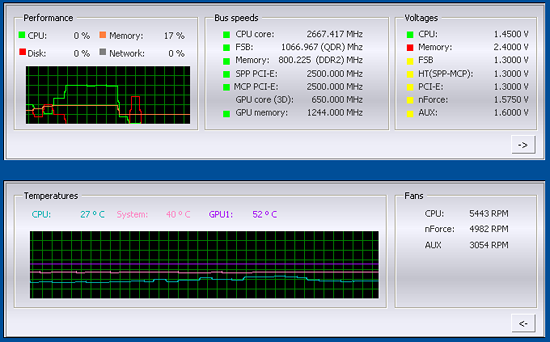
NVIDIA also includes a System Information utility along with a Windows based monitoring application. Overall, the polished look, feel, and operation of the new control panel along with the performance improvements offered in nTune 5.05 has raised the bar once again for user enhancements offered by the core logic suppliers.
One of most interesting features at the nForce 500 launch was the revamped control panel and nTune 5.0 performance applications. The Control Panel and nTune have undergone some fine tuning the past few months with version 5.05 launching for the nForce 600 and GeForce 8800 series of products shortly. NVIDIA has combined all of their various program applets into an integrated control panel to provide a common user interface. We found that this common interface makes it easier for a user to control the various functions of the board and video (NVIDIA based) from a central access point.
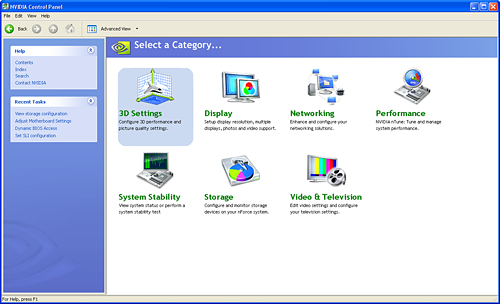 |
| Click to enlarge |
The new control panel offers configuration sections for 3D Settings for NVIDIA GPUs, Display settings, Networking options, Performance, System Stability testing, Storage, and Video/Television settings. The information contained in each section will already be familiar to those with nForce4 or nForce 500 boards but will include a few extended configuration options for the nForce 600 and GeForce 8800 products.
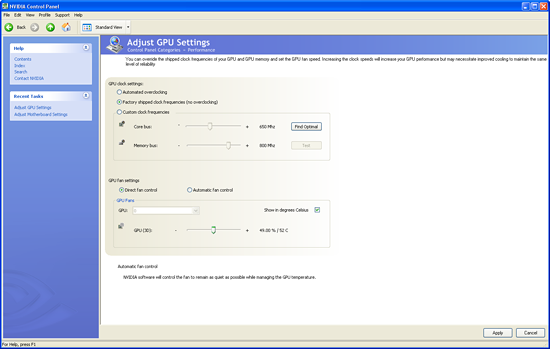 |
| Click to enlarge |
One noteworthy change with the GeForce 8800 series is that Coolbits no longer works for overclocking the GPU. The overclocking panel will still be visible in the legacy control panel but it will tell you to download nTune in order to overclock your GPU. The new GPU overclocking utility works in the same manner but is now integrated into the revised Control Panel.
 |
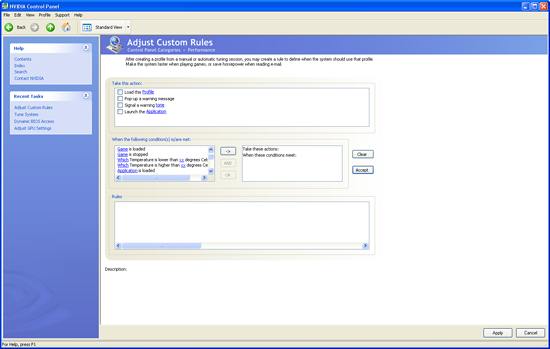 |
| Click to enlarge |
One of the more interesting features for us is the Adjust Motherboard Settings application. We found the ability to dynamically write a significant number of performance settings directly to the BIOS without requiring a reboot a very quick and easy way to test or set overclocking options without exiting Windows. There are several third party applications that perform this same function but we believe the official support within the BIOS and nTune software gives it a significant advantage over the other solutions. The settings can be saved in a profile that can be loaded within Windows without having to reset the BIOS for individualized situations where settings for games might differ from those for audio/video playback. The system also allows for automatic or direct fan control on supported fan headers.
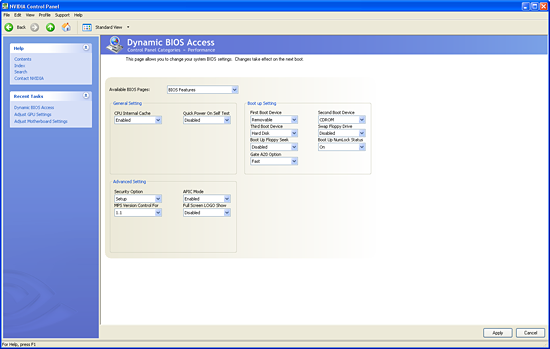 |
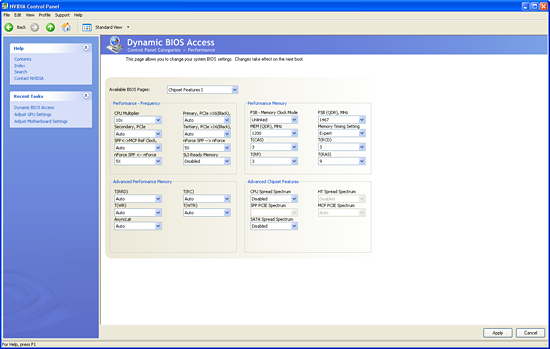 |
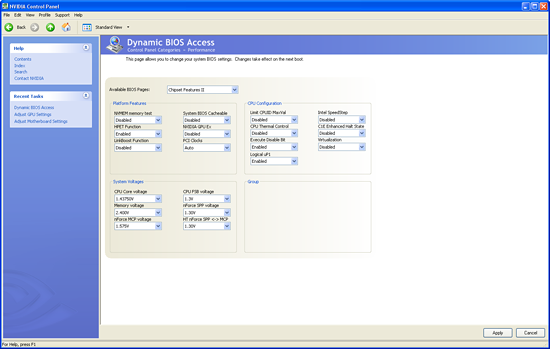 |
| Click to enlarge |
The Dynamic BIOS Access section offers the ability to change BIOS setting in five different categories that will take effect on reboot. The two sections not displayed are for power management and peripheral settings.
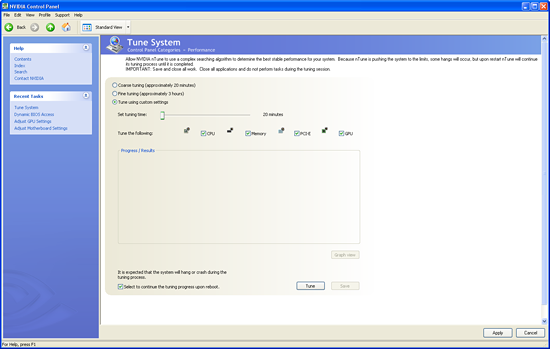 |
| Click to enlarge |
If you are not the type to enter the BIOS and tune your system or set it up for overclocking then NVIDIA offers an application that can do it for you based on your combination of components. We found the Coarse Tuning option would generally set up our system for a 6%~9% overclock of the FSB and memory along with a 3%~5% overclock on the GPU. The Fine Tuning option resulted in an 8%~15% overclock of the FSB and memory while the GPU usually increased 5%~8%.
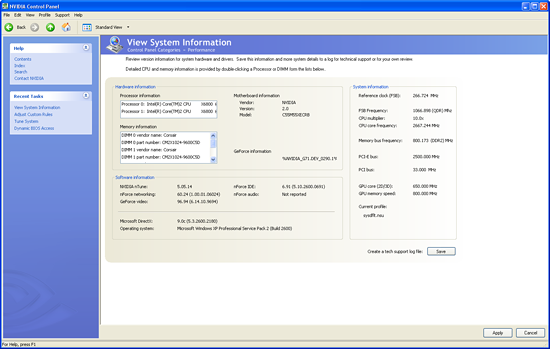 |
| Click to enlarge |

NVIDIA also includes a System Information utility along with a Windows based monitoring application. Overall, the polished look, feel, and operation of the new control panel along with the performance improvements offered in nTune 5.05 has raised the bar once again for user enhancements offered by the core logic suppliers.










60 Comments
View All Comments
MikeyC - Friday, November 10, 2006 - link
I'm looking forward to this. Any idea on when you guys will have the bin numbers for the different rates of OC-ability? I'm planning on OCing my e6600 on this board this weekend; I'll post up my numbers if that'll help.Gary Key - Sunday, November 12, 2006 - link
We have not figured it out yet. Two CPUs from the same week and they both act differently during overclocking. We are still working with NVIDIA on this matter.Joepublic2 - Friday, November 10, 2006 - link
965 and 975 boards to my knowledge don't support a FSB/mem ratio smaller than 1:1. Does this chipset have the right multiplier to use DDR2-400 while retaining a 1066Mhz FSB?Gary Key - Friday, November 10, 2006 - link
The memory settings are sync or async capable on this chipset if you unlink the FSB and Memory in the BIOS. So the answer is yes to your question but believe me this chipset needs good DDR2-800 to get the most out of it. A 1T command rate can make a significant difference in several applications and games. We already found a 4FPS difference in Q4 at 1280x1024 with DDR2-800 at 1T instead of 2T as an example. We will have more on this in our actual board review.Joepublic2 - Monday, November 13, 2006 - link
I was asking mainly because a conroe board that could run a 4:3 FSB/mem multiplier could be an even better overclocker than the 965. One would only need RAM that could hit DDR 752 for a 500Mhz FSB for example.A great review as always!
VooDooAddict - Friday, November 10, 2006 - link
Any idea if there are mATX boards using any of thse new chipsets on the way?Gary Key - Friday, November 10, 2006 - link
There is the possibility of the 650i Ultra being on a mATX board in late January. However, the suppliers might wait for the new NV Intel IGP chipset coming in Q1. We should have more information in December.
BadThad - Thursday, November 9, 2006 - link
Should be CPU, the X6800 is not a GPU, lol.
Wesley Fink - Friday, November 10, 2006 - link
Correctedyacoub - Thursday, November 9, 2006 - link
Do all of the 680i SLi boards require active cooling on the northbridge? That's actually a deal-killer for me, as motherboard fans are about the worst ones out there anymore since they're small, fast-spinning (and due to those two characteristics they are noisy), usually short-lived, and I've yet to see one that is dynamically controlled by the temp of the northbridge.I'm guessng 650i boards don't require active cooling, but are any of the 680i boards using a non-reference design sporting completely silent cooling?